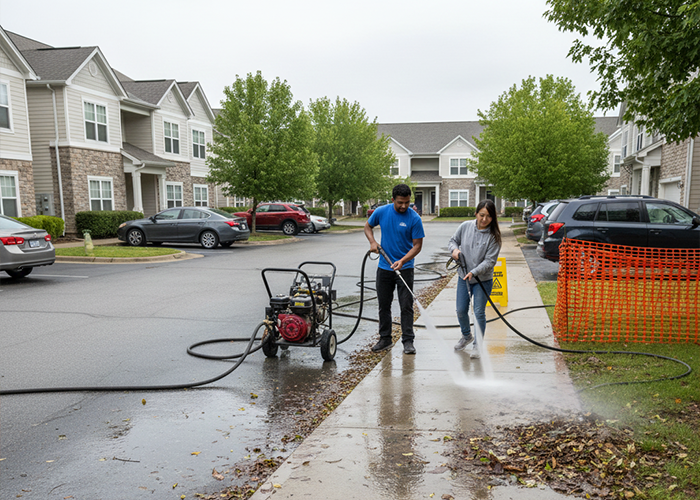How to Handle Emergency HOA Repairs
When something goes wrong in a community, minutes feel long and small delays can turn into big invoices. That is why a clear plan for emergency HOA repairs matters so much for boards, managers, and residents. With a good response process and the right vendors on call, you can protect property values, keep people safe, and bring the community back to normal more quickly.
Planning for Emergency HOA Repairs Before They Happen
The best time to think about emergency HOA repairs is before you actually need them. A written emergency repair plan gives board members and managers a step-by-step guide when a pipe bursts, a tree falls, or a walkway becomes unsafe. Instead of guessing what to do next, everyone knows who to call, what to document, and how to keep residents informed.
A good plan lists out the types of issues that count as emergencies in your community. It also sets target response times and clear roles for the board, management, and vendors. When people know their jobs ahead of time, they can move faster and with less confusion.
Vendor contact information is another key piece. Keep a short list of trusted partners for plumbing, electrical work, roofing, and exterior cleaning, including a pressure washing company that offers fast service when surfaces become slippery or damaged. Store this list in an easy place, both digitally and in print, so it is never hard to find.
Common Emergency Repairs In HOA Communities

Every community is different, but many face similar urgent problems. Water is a frequent culprit. Burst pipes, broken sprinkler lines, and roof leaks can damage drywall, flooring, and building exteriors in a short time. If water reaches sidewalks or stairs, it can also create slip hazards for residents.
Storms bring another set of issues. High winds can bring down branches or entire trees, which may block roads, damage roofs, or hit vehicles. Heavy rain can wash debris across parking lots and pathways, and standing water may leave behind mud, algae, or oil that needs quick cleanup.
You also have emergencies that affect shared systems and high-traffic areas. A failed pool pump, damaged exterior lighting, or a broken handrail can pose safety risks. When these problems touch common surfaces, fast pressure washing or surface cleaning can help clear away dirt, mold, or other residue that builds up while repairs are underway.
Building A Clear Emergency Response Process
When emergency HOA repairs are needed, a simple and repeatable process helps everyone stay calm. Start with reporting. Give residents clear instructions on how to report urgent issues, including a phone number or online portal for after-hours calls. Make sure they know what details to share, such as location, photos, and any immediate safety concerns.
Once a report comes in, someone needs to triage. That might be the community manager or a board member on call. Their job is to confirm the situation, decide how urgent it is, and contact the right vendor. Many associations use a tiered approach, where life safety and active damage come first, while less urgent issues are scheduled soon after.
Documentation should be part of the process from the start. Take photos, keep notes on conversations, and track timelines. Good records help with insurance claims, vendor reviews, and future planning. They also show homeowners that the board takes emergency HOA repairs seriously and handles them with care.
Communicating With Residents During Emergency Repairs

Residents get anxious when they see trucks, caution tape, and closed areas with no explanation. Clear communication can ease that stress. When emergency repairs happen, send a short update through email, text messages, or your community portal. Explain what happened in simple terms, what is being done, and any steps residents should take.
As work continues, keep people in the loop. Let them know when crews will be on site, which areas to avoid, and how long disruptions may last. If pressure washing is planned to clean walkways or building exteriors, warn residents about potential noise, water spray, or temporary closures of sidewalks and parking spaces.
Communication should be two-way. Encourage residents to share any new issues they notice, such as additional leaks, loose debris, or slick surfaces. Quick feedback from people who live on site can help catch problems your team cannot see from the office.
Coordinating With Vendors For Emergency Repairs
Strong vendor relationships make emergency HOA repairs easier to handle. Before a crisis hits, talk with your key vendors about their response times, after-hours procedures, and pricing for urgent calls. Put those terms in writing so there are no surprises when you need help at night or on a weekend.
It helps to identify vendors who understand how HOAs operate. They should know that they are working in shared spaces with many residents around. Good partners respect quiet hours where possible, follow community rules, and keep work sites neat. For a pressure washing company, that may mean using proper signage, controlling water runoff, and scheduling work to avoid the busiest times.
Whenever possible, give vendors a basic map of the property and a list of priority areas. Show them where access points, shutoff valves, and key common areas are located. When they arrive for an emergency, they can get to work faster if they already know the layout.
How Pressure Washing Supports Emergency HOA Repairs

Pressure washing often feels like a routine service, but it plays an important role when emergencies happen. After a storm, sidewalks, entryways, and parking lots can collect mud, leaves, and other debris. Fast pressure washing can clear these areas, reduce slip risks, and make it easier for other contractors to do their work.
Water damage can leave behind stains, mold, and algae on concrete, siding, and pool decks. Leaving these residues in place can create health and safety concerns over time. A pressure washing crew that responds quickly can help the community recover, restore curb appeal, and keep surfaces from becoming slick or discolored.
Emergency repairs sometimes involve oil leaks, soot, or chemical spills on exterior surfaces. In those situations, your pressure washing partner may use special techniques or cleaning agents to remove the problem material. Their work supports the rest of your emergency response by making sure the community looks cared for and feels safe to walk through again.
Keeping Safety Front And Center
Safety should guide every decision during emergency HOA repairs. Before contractors start work, make sure hazardous areas are blocked off with cones, tape, or temporary fencing. Place clear notices at building entrances and around active work zones so residents can choose safe routes.
Walk the site with your vendors when possible. Talk through any risks they see, such as tripping hazards, loose materials, or surfaces that might become slippery during cleaning. When pressure washing is involved, make plans for managing runoff, securing hoses, and preventing residents from walking on wet surfaces.
After work finishes, do one more safety check. Confirm that debris is removed, signage is updated, and barriers are taken down only when it is safe to do so. A short final walk-through often catches small problems you might have missed earlier.
Budgeting And Insurance For Emergency HOA Repairs

Even with a strong reserve fund, emergency HOA repairs can put real pressure on the budget. Planning for this starts with regular reserve studies and a clear annual budget line for unexpected repairs. When you know you have some funds set aside for emergencies, decisions are easier to make.
Insurance is another part of the picture. Review your association’s policies to understand what types of emergency repairs may be covered. Water damage, storm impacts, and certain structural issues might fall under your master policy, while some items may be excluded. Keeping good documentation and photos from the start helps speed up any claim.
When you receive invoices from contractors, including your pressure washing company, keep them organized by incident. Group work orders, before-and-after photos, and communications together. This helps the board explain spending to homeowners and supports any future audits or insurance questions.
Using Preventive Maintenance To Reduce Emergencies
Not every emergency can be avoided, but regular care can reduce how often they happen. Routine inspections of roofs, gutters, irrigation systems, and drainage can catch many issues while they are still small. Fixing a minor leak or loose flashing costs far less than a major water event.
Exterior cleaning is part of that preventive work. Regular pressure washing of sidewalks, stairs, building exteriors, and amenity areas helps remove mold, algae, and dirt that hold moisture against surfaces. Cleaner areas are easier to inspect, and problems such as hairline cracks or loose railings become easier to spot.
You can also use maintenance records to find patterns. If the same stairwell or section of sidewalk shows repeated issues, consider a more permanent fix. That might mean better drainage, upgraded materials, or a more frequent cleaning schedule with your pressure washing partner.
Reviewing And Improving After An Emergency

Once the dust settles, it is worth taking time to review how the emergency was handled. Bring together the board, the manager, and key vendors to talk through what worked and what could be improved. Keep the conversation practical and focused on better results next time.
Look at how quickly emergency HOA repairs were started, how communication flowed, and whether residents followed instructions. Ask vendors for feedback on access issues, decision making, and any delays they noticed. Their perspective can highlight simple changes that make a big difference.
Update your written plan based on what you learn. Add vendor notes, revise contact lists, and adjust your communication templates. Treat each emergency as a learning moment so the next response is smoother and more effective.
Helping Your Community Stay Ready
Emergency HOA repairs will never be completely stress free, but preparation takes away much of the guesswork. When your community has a clear plan, strong vendor relationships, and a thoughtful approach to safety, you can handle unexpected problems with more confidence. Working closely with a reliable pressure washing company and other trusted contractors also makes it easier to protect both property and people when it matters most.
Related Articles:

